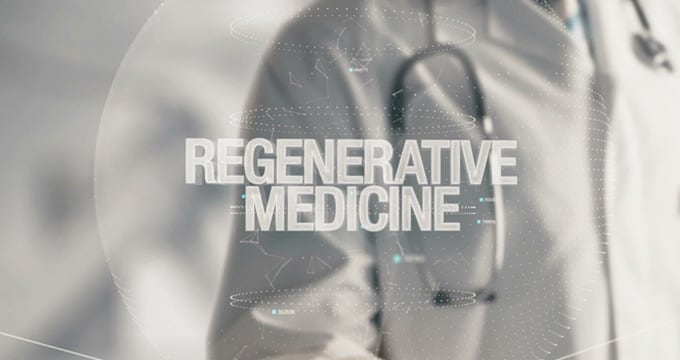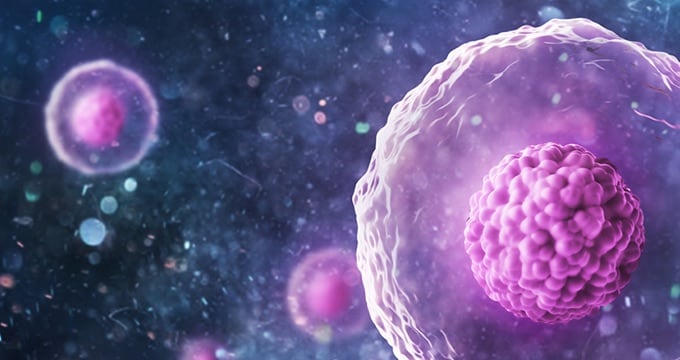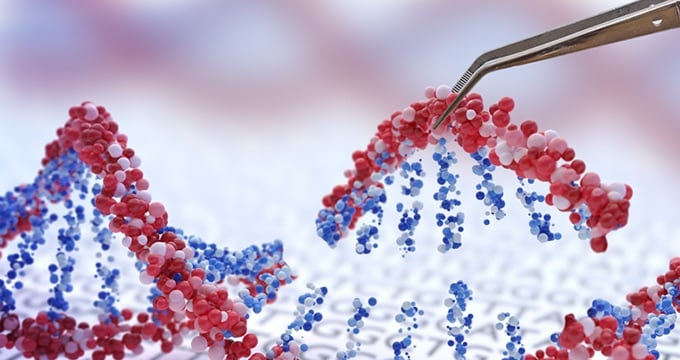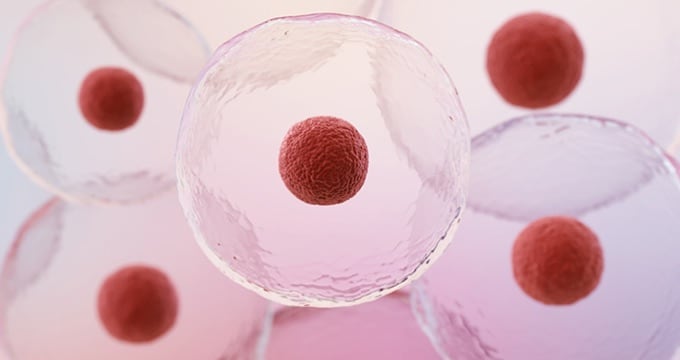We introduced gene therapy products in our previous paper. In this paper, we will focus on "Gene therapy using genome editing technology" among gene therapy products.
> Regenerative Medicine Column: What is Gene Therapy Products?(This will open in a new window.)
The term "genome editing" became widely known when “CRISPR/Cas9 system” was awarded the Nobel Prize in Chemistry in 2020.
Genome editing is a technology that uses artificially created “enzymes that specifically cut targeted DNA sequences and the living organism's innate ability to repair DNA breakage to modify targeted locations on the genome.
The mechanism begins when a specific site in the genome is cut by “enzymes introduced into the cell that specifically cuts the targeted DNA sequence”. DNA artificially cut by enzymes is repaired by two DNA repairing mechanisms (Non-homologous end joining and Homologous recombinants) that living organisms possess.
However, since there are still “enzymes that specifically cut the targeted DNA sequence” in the cell, the repaired area is cut again. When the part is severed again, it is repaired again by the repair function of the organism.
However, if the artificial cleavage enzyme in the cell repeatedly happens, some errors may occur in the process of repairing the cleaved site. Errors in the repair process by non-homologous end joining can result in insertions or deletions of a few bases.
In other words, it is possible to disrupt specific genes by inserting or deleting a few bases at targeted positions in the genome.
On the other hand, errors in the repair process by homologous recombinants can lead to the incorporation of foreign genes. In other words, if “the enzyme that specifically cuts the target DNA sequence” and “the gene to be introduced” are placed in the same cell, it is possible to introduce the desired gene into the targeted position in the genome. In conclusion, the genome editing technology makes it possible to destroy a targeted gene or insert a gene in a targeted location.
In previous gene therapy, it was impossible to insert genes at targeted locations in the genome. Therefore, the only method available was to introduce a new gene into a different location from the causal gene of the disease.
However, the genome editing technology can modify the targeted position in the genome, making it possible to correct the genetic abnormality causing the disease. For this reason, gene therapy using the genome editing technology is expected to become the ultimate gene therapy technology.
The genome editing technology is a newly developed genetic modification technology. However, clinical trials using the genome editing technology have been already implemented in the world.
One example of a treatment using genetic disruption is a treatment for AIDS. This is an ex vivo gene therapy method. In this therapy, ZFNs (first generation genome editing enzymes = DNA cutting enzymes) are introduced into T cells taken from the patient to destroy a CCR5 gene, and then the T cells are returned into the patient's body.
> Regenerative Medicine Column: What is Gene Therapy Products?(This will open in a new window.)
CCR5 is a receptor for Human Immunodeficiency Virus (HIV) that causes AIDS when the virus infects T cells. By destroying the gene of the receptor, the gene therapy prevents HIV from infecting T cells.
On the other hand, one treatment example using gene transfer is a treatment for mucopolysaccharidosis type 2. Mucopolysaccharidosis type 2 is a disease that causes abnormal development and mental retardation due to the accumulation of glycosaminoglycans in the body caused by genetic abnormality in isulonate-2-sulfatase (IDS) which is an enzyme that breaks down glycosaminoglycans, a type of mucopolysaccharide.
To treat this disease, AAV vectors are used to introduce the normal IDS gene into downstream of the albumin gene promoter in liver cells. Since the albumin gene is actively transcribed in liver cells, the IDS gene introduced into downstream of the albumin gene promoter is also actively transcribed, and the symptoms are improved by degrading the accumulated glycosaminoglycans with IDS protein produced.
Noticeable CAR-T cells

Furthermore, the genome editing technology has been also used to develop new therapeutic cells. One of them is "Universal CAR-T cell," which is a combination of CAR-T cells and the genome editing technology.
CAR-T cells are used in the treatment of cancer and are known to demonstrate excellent clinical efficacy in blood cancers such as acute lymphoblastic leukemia and malignant lymphoma. As of January 2021, two products “Kymriah” and “YESCARTA®” have been approved in Japan.
CAR-T cells are produced by introducing "Chimeric Antigen Receptor (CAR)" into T cells with the abilities to attack cells. The CRA is an artificially created protein on the cell membrane, and it transmits the binding signal into the cell and activates the T cell when it bounds to a cancer cell in the extracellular region.
In other words, when CAR-T cells bind to cancer cells, the CAR-T cells become activated, attack and kill the bound cancer cells.
Both of the two currently approved products are autologous products in which T cells are extracted from the patient's own body and the CAR gene is introduced at a factory. Since the patient's own T cells are used, the safety is relatively high. However, there are some specific issues because these are autologous products.
One of the challenges is that the patient's T cells are weakened by the cancer treatment and may not be able to produce CAR-T cells properly.
Patients who undergo CAR-T cell therapy have already received various anticancer drugs and radiation therapy. These treatments affect not only cancer cells but also T cells, so the T cells of the patients are weaker than those of healthy people. If the T cells are too weak, they cannot grow, and CAR-T cells may not be manufactured.
Another issue is that it takes one to two months to manufacture CAR-T cells, so there are some cases where the patients’ medical conditions deteriorate during the manufacturing process and the CAR-T cells cannot be administered to the patients.
In order to solve these problems, development of CAR-T cells of other people has been conducted in which CAR-T cells are manufactured in advance by collecting T cells from other healthy people. With the use of CAR-T cells of other people, there is no risk of not being able to manufacture them, and there is no waiting time because the already manufactured-cells are administered to patients.
However, there are significant barriers to use T cells of other people for therapy. This is due to the fact that T cells derived from other people may attack the patient's normal cells since the cells are not the patients’ own cells.
In order to solve this issue, development of "universal CAR-T cells" in CAR-T cells which cannot attack patients' normal cells have been underway by using the genome editing technology to disrupt the gene for the "T-cell receptor," which is used by T cells to recognize self and non-self. If "universal CAR-T cells" become reality, it is expected that more patients can gain benefits from CAR-T cell therapy.
Under these circumstances, there is a high possibility that clinical trials using the genome-editing technology will be implemented in Japan. As a preparation for such trials, discussions on the ideal form of gene therapy using the genome-editing technology were held at the meeting of the PMDA Scientific Committee Expert Group from November 2018 to October 2019.
As deliverables of this discussion, the classification of genome editing tools that have been confirmed, their quality characteristics, and views on the concept of safety assessment when used for therapy are published.
In addition, legislation toward gene therapy has been developed. When clinical researches and clinical trials using gene therapy are conducted, it is necessary to comply with "Guidelines for Clinical Research on Gene Therapy, etc." However, the definition of gene therapy in the previous guidelines didn’t include all the diversifying genome editing technologies.
Therefore, on February 28, 2019, the guidelines including the definitions were revised, and researches using the genome editing technology are now clearly within the applicable scope of the guidelines.
Definition of gene therapy
- Before revision:
- To administer genes or gene-transformed cells into the human body
- After revision:
- (1) To administer genes or gene-introduced cells into the human body
- (2) To modify a person's genes by targeting specific base sequences
- (3) To administer cells with altered genes into the human body
In addition, when vivo gene therapy is conducted, it is necessary to comply with the Act on Securing the Safety of Regenerative Medicine, etc. This act was revised on June 26, 2020, and human cells genetically modified by the genome editing technology are now clearly subject to the Class I Regenerative Medicine Technology.
Class I Regenerative Medicine Technology
- Before revision:
- Medical technology using genetically engineered-cells or cells that have been cultured or processed.
- After revision:
- Medical technology using cells that have undergone gene transfer or modification, or cells that have been cultured or processed.
Remedy Group is constantly deepening its knowledge of such new regenerative medicines, and aims to provide appropriate exit strategies for product development that has not been conducted by anyone yet.
Reference: Report on Considerations for the Quality and Safety of Gene Therapy Products Using Genome Editing Technology, etc.










